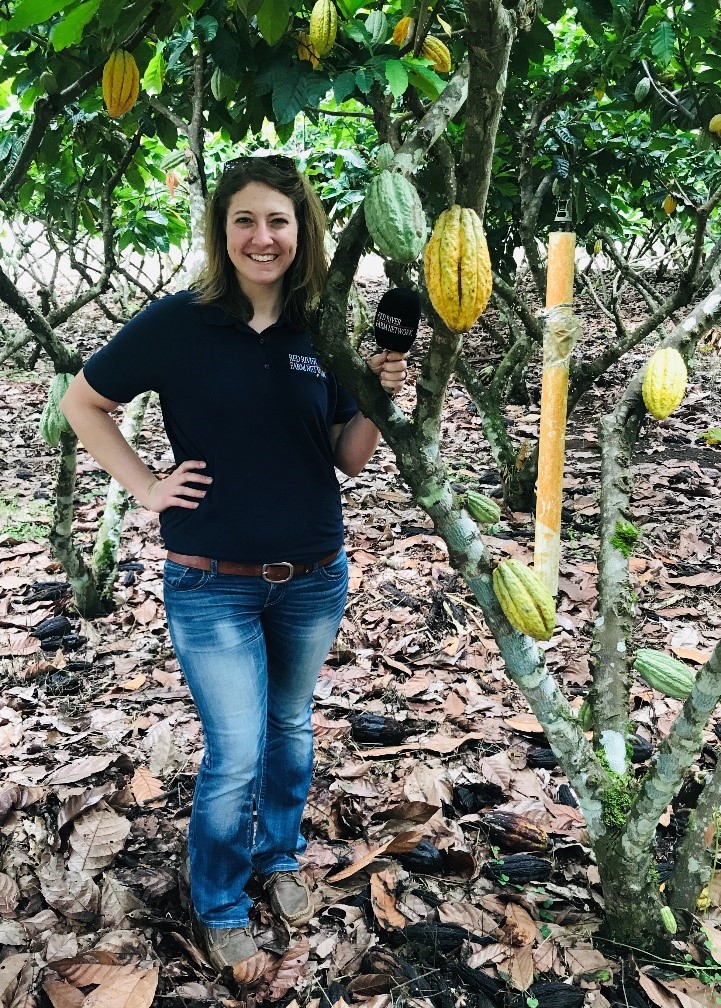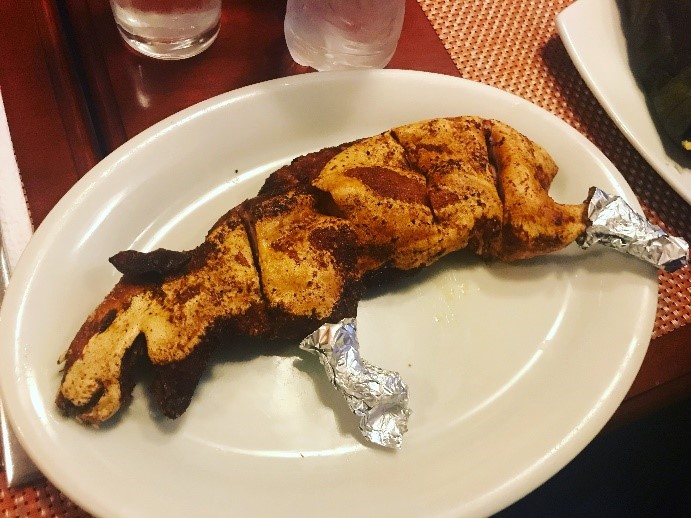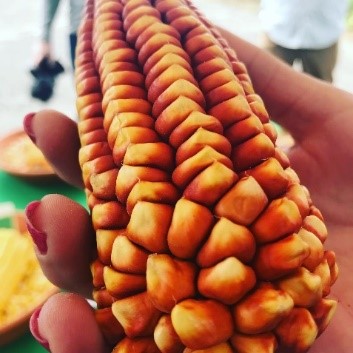 On a bus traveling from the lowlands of Ecuador toward the Quito airport, Carah Hart (Red River Farm Network, Grand Forks, North Dakota) reflected on her trip. “It has been one great week reporting agriculture’s business. Looking out the window, there’s the lush green vegetation of a cloud forest. The climate is warm and humid. My hair has gone from straight to frizzy. I also smell like bug spray, sweat and dirt,” Hart noted. “Telling the story of local farmers intertwining in Ecuadorian agriculture was the opportunity of a lifetime,” she said. In January, Hart joined 12 members of the Red River Valley Ag Peer Group for a weeklong tour of the country. This was her first international reporting experience. The group learned all about local agriculture and consumed more quality chocolate and floury corn than ever thought possible.
On a bus traveling from the lowlands of Ecuador toward the Quito airport, Carah Hart (Red River Farm Network, Grand Forks, North Dakota) reflected on her trip. “It has been one great week reporting agriculture’s business. Looking out the window, there’s the lush green vegetation of a cloud forest. The climate is warm and humid. My hair has gone from straight to frizzy. I also smell like bug spray, sweat and dirt,” Hart noted. “Telling the story of local farmers intertwining in Ecuadorian agriculture was the opportunity of a lifetime,” she said. In January, Hart joined 12 members of the Red River Valley Ag Peer Group for a weeklong tour of the country. This was her first international reporting experience. The group learned all about local agriculture and consumed more quality chocolate and floury corn than ever thought possible.
The tour began in the highlands. After climbing hills and exploring the architecture of Quito, the group visited the equator and sampled high-quality coffee and chocolate. The next few days were filled with a look into Ecuador’s agriculture extension/research system and their maize, wheat, and potato production. There also were also tours of a flour mill and cookie production facility. Midweek, the group started travel into the lowlands. “Infrastructure challenges were evident after a several-hour traffic jam caused by a landslide. Agriculture looks a lot different in the lowlands,” Hart observed. Bananas, fresh flowers, and cacao are grown in the area where humidity is high. The cacao is made into high- quality chocolate. Coffee beans also are produced in the lowlands. Trips to the local farmer’s market were common. “When people think of South American agriculture, they may not think of Ecuador. Yet, it is an interesting growing region. The climate varies. In the highlands, near Quito, it feels like spring. In the lowlands, near Santo Domingo, it feels like summer. There is a wet and dry season,” she noted. The Ag Peer Group toured during the wet season.
Being right along the equator, a tour guide explained Ecuador doesn’t experience tornadoes or hurricanes because of its location. Ecuador also has diverse soils. In the highlands, near Quito, the soil consists of volcanic ash with about six percent organic matter. During tours, the group walked in muddy fields, but no mud stuck to their shoes. They also observed a slight sparkle to the soil. “Traditions impact Ecuador’s agricultural production. Many farmers grow crops or raise livestock a certain way because that’s how their family has always done it. Production is not always efficient. There are few who are exploring new ways to produce food and testing different methods to boost yields, at least in the highlands. Genetically Modified Organisms also aren’t being used in the highlands of Ecuador,” she said. It’s common to see corn plots popping up in the middle of Quito or randomly out of the city. The plots are in different growth stages and much taller than Iowa corn. The Ag Peer Group visited many farms growing maize. “There’s not much wheat production in the country, but it’s a great spot to learn more about yellow rust. Many farmers grow crops just to feed their families.

 At meals, fresh fruit, juice, and guinea pigs are usually available. Everyone in the group tried guinea pig (pictured left) at least once. It was common to have the option of soup at breakfast along with other items. A typical lunch and supper could consist of floury corn and pork. Ecuadorians also love their soup. When they serve it, soup is offered with popcorn (popped or just the kernels) and sometimes fresh avocado. Potato soup is a popular choice,” Hart explained.
At meals, fresh fruit, juice, and guinea pigs are usually available. Everyone in the group tried guinea pig (pictured left) at least once. It was common to have the option of soup at breakfast along with other items. A typical lunch and supper could consist of floury corn and pork. Ecuadorians also love their soup. When they serve it, soup is offered with popcorn (popped or just the kernels) and sometimes fresh avocado. Potato soup is a popular choice,” Hart explained.
Throughout her tour, two reports aired on the Red River Farm Network (RRFN) each day, along with three Facebook Live broadcasts. “Limited Internet access on the road made evening and morning work hours very important. Taking in the surroundings was also very different while reporting. I got to know some of the farmers and translators well because of interviews,” she added. After returning home, the Ag Peer Group continues to use RRFN’s reports to document the trip. They are sharing reports with sponsors and farm groups to continue telling the story. This has caught the attention of a few USDA officials. Hart hopes there will be more opportunities for international reporting in the future. The Red River Valley Agriculture Peer Group plans to do more international travel. Since 2017, a diverse group of about 30 young ag professionals meet several times each year to learn from one another and grow in their leadership. “There is hope these young farmers will transition into more industry leadership,” Hart concluded. Listen to Hart’s Ecuador reports.


 On a bus traveling from the lowlands of Ecuador toward the Quito airport, Carah Hart (Red River Farm Network, Grand Forks, North Dakota) reflected on her trip. “It has been one great week reporting agriculture’s business. Looking out the window, there’s the lush green vegetation of a cloud forest. The climate is warm and humid. My hair has gone from straight to frizzy. I also smell like bug spray, sweat and dirt,” Hart noted. “Telling the story of local farmers intertwining in Ecuadorian agriculture was the opportunity of a lifetime,” she said. In January, Hart joined 12 members of the Red River Valley Ag Peer Group for a weeklong tour of the country. This was her first international reporting experience. The group learned all about local agriculture and consumed more quality chocolate and floury corn than ever thought possible.
On a bus traveling from the lowlands of Ecuador toward the Quito airport, Carah Hart (Red River Farm Network, Grand Forks, North Dakota) reflected on her trip. “It has been one great week reporting agriculture’s business. Looking out the window, there’s the lush green vegetation of a cloud forest. The climate is warm and humid. My hair has gone from straight to frizzy. I also smell like bug spray, sweat and dirt,” Hart noted. “Telling the story of local farmers intertwining in Ecuadorian agriculture was the opportunity of a lifetime,” she said. In January, Hart joined 12 members of the Red River Valley Ag Peer Group for a weeklong tour of the country. This was her first international reporting experience. The group learned all about local agriculture and consumed more quality chocolate and floury corn than ever thought possible.
 At meals, fresh fruit, juice, and guinea pigs are usually available. Everyone in the group tried guinea pig (pictured left) at least once. It was common to have the option of soup at breakfast along with other items. A typical lunch and supper could consist of floury corn and pork. Ecuadorians also love their soup. When they serve it, soup is offered with popcorn (popped or just the kernels) and sometimes fresh avocado. Potato soup is a popular choice,” Hart explained.
At meals, fresh fruit, juice, and guinea pigs are usually available. Everyone in the group tried guinea pig (pictured left) at least once. It was common to have the option of soup at breakfast along with other items. A typical lunch and supper could consist of floury corn and pork. Ecuadorians also love their soup. When they serve it, soup is offered with popcorn (popped or just the kernels) and sometimes fresh avocado. Potato soup is a popular choice,” Hart explained.